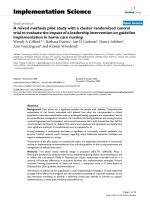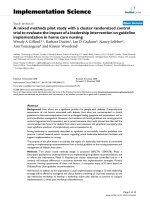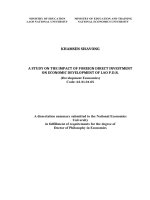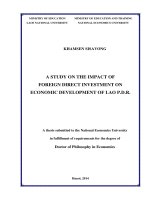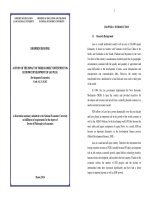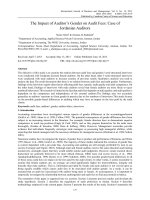The Impact Of Human Capital Development On Economic Growth In Ethiopia: Evidence From Ardl Approach To Co-Integration
Bạn đang xem bản rút gọn của tài liệu. Xem và tải ngay bản đầy đủ của tài liệu tại đây (1.2 MB, 81 trang )
THE IMPACT OF HUMAN CAPITAL DEVELOPMENT ON
ECONOMIC GROWTH IN ETHIOPIA: EVIDENCE FROM ARDL
APPROACH TO CO-INTEGRATION.
Msc. Thesis
By:
Kidanemariam Gidey Gebrehiwot
June, 2013
Addis Ababa
THE IMPACT OF HUMAN CAPITAL DEVELOPMENT ON
ECONOMIC GROWTH IN ETHIOPIA: EVIDENCE FROM ARDL
APPROACH TO CO-INTEGRATION .
A Thesis Submitted to the Department of Development Economics, Institute of Public
Management and Development Studies (IPMDS), School of Graduate studies,
ETHIOPIAN CIVIL SERVICE UNIVERSITY.
In partial Fulfillme nt of the Require ments for the Degree of
MASTERS OF SCIENCE IN DEVELOPMENT ECONOMICS
BY
Kidanemariam Gidey Gebrehiwot
June, 2013
Addis Ababa
DECLARATION
First, I declare that this thesis is the result of my own work and that all sources or materials
used for this thesis have been duly acknowledged. This thesis has been submitted in partial
fulfillment of the requirements for M.Sc. degree in Development Eco nomics at Ethiopian
Civil Service University and is deposited at the University’s library to be made available to
borrow under the rules of the library. I solemnly declare that this thesis is not submitted to any
other institutions anywhere for the award of any academic degree, diploma, or certificate.
Brief quotations from this thesis are allowable without special permission, provided that
accurate acknowledgement of source is made. Requests for permission for extended quotation
from or reproduction of this manuscript in whole or in part may be granted by the head of the
major department or the Dean of the School of Graduate Studies when in his or her judgment
the proposed use of the material is in the interests of scholarship. In all other instances,
however, permission must be obtained from the author.
Name :__________________
Signature: __________________
Place: ______________________
Date of Submission: June ____, 2013
i
APPROVAL OF BOARD EXAMINERS
SCHOOL OF GRADUATE STUDIES
ETHIOPIAN CIVIL SERVICE UNIVERSITY
As members of the Examining Board of the Final M. Sc. Thesis Open Defense, we certify that
we have read and evaluated the Thesis prepared by Kidane mariam Gidey Gebrehiwot
entitled The Impact of Human capital Development on Economic Growth and
recommend that the Thesis is accepted as fulfilling the thesis requirement for the degree of
Master of Science in Development Economics.
_________________
_________________
Name of Chairman
Signature
________________
_________________
Name of Major Advisor
Name of Internal Examiner
_________________
Date
_________________
Name of External Examiner
_________________
Date
Signature
_________________
_________________
Signature
_________________
Date
_________________
Signature
_________________
Date
Final approval and acceptance of the thesis is contingent upon the submission of the final
copy of the thesis to the Council of Graduate Studies (CGS) through the Departmental
Graduate Committee (DGC) of the candidate’s major department.
I hereby certify that I have read this thesis prepared under my direction and recommend that it
be accepted as fulfilling the thesis requirement.
_________________
Name of Thesis Advisor
_________________
Signature
_________________
Date
ii
BIOGRAPHY
Kidanemariam Gidey Gebrehiwot was born in “Tanbuklo” village near Adigrat city, in Tigray
National Regional State, in the Northern part of Ethiopia on October, 1980. He attended his
elementary and junior education in Abyot-Chora Elementary and junior School at
Shashemene city in Oromiya National Regional State. He attended his high school education
in two schools namely, Shashemene high school and Shire-Endasilasie high school. After
completion of his high school education, he joined Mekelle University and got his B.A.
Degree in Economics in 2006. After that he was employed in Bureau of Finance and
Economic Development (BoFED) of the Tigray National Regional State and served for about
five years as a macroeconomic policy analyst. Then, he joined the Ethiopian Civil Service
University in October, 2011 to follow his postgraduate studies for the M.Sc. in Development
Economics.
iii
ACKNOWLEDGEMENT
This thesis would not have been possible without the support of many people. First and
foremost, I would like to thank to my Advisor, Ato Nahu Asteraye for his valuable guidance,
constructive comments and encouragement which was very important input to conduct this
study. I am also very thankful to my brother Kahsay Tsegay , my brother Kiflemariam Gidey,
my friend Alemaw Berhe and my friend Hintsa Tsigab who has been a source of courage ,
inspiration , and financial & material support in the course of my thesis writing and the whole
learning process. It is with immense gratitude that I acknowledge the reference material
support of Prof. Yilma Gebremariam.
I am also very grateful to my beloved Wife Asmeret Gebreyesus for her practical &
psychological support. As she carried double responsibility in our house and business,
especially in nurturing our lovely daughter (Nardos Kidanemariam), her contribution to the
completion of my paper and the success of my learning process was very fundamental. In
addition, I would also like to acknowledge with much appreciation the crucial role of the
ECSU university leaders & employees; my class mates and other ECSU university students
who surprisingly simplified my mobility problem. A special thank goes to Ato Yemane Yosef
( NBE Vice Governor, Corporate Service), Ato Demirew Getachew (Head, EEA secretariat),
W/rt Eyerusalem (EEA librarian) and my class mates who helped me in data collection.
Furthermore, many thanks go to the head of my department, Ato Gashaw Tsegaye (Head of
the Department of Development Economics), Ato Sherif Muzeyin (Head of the ECSU
Training, Hospitality and Accommodation Support Process), Mahilet Fiseha (Secretary of the
Department of Development Economics), and Baye Sisay (Binding and Sorting Messenger of
the Department of Development Economics) for their responsible administrative support. Last
but not least, I would like to thank to Ato Hailay Tsigab and Ato Tadele Tafese for their
editorial support. Finally, I am also grateful to all who helped me morally and materially on
course of my study.
iv
TABLE OF CONTENTS
PAGE
DECLARATION………………………………………..…………….......................
i
APPROVAL OF BOARD EXAMINERS…………………………….......................
ii
BIOGRAPHY…………………………………………..………………………….…
iii
ACKNOWLEDGEMENT………………………………………………………...…
iv
LIST OF TABLES………………………………………..……………………….…
viii
LIST OF FIGURES……………………………………………………………..…...
ix
LIST OF APPENDICES……………………………………..……………………....
ix
LIST OF ACRONYMS………………………………………..……………….….…
x-xi
ABSTRACT.................................................................................................................
xii
CHAPTER ONE……………………………………………………………….....…
1
INTRODUCTION……………………………………………….……….…..……..
1
1.1 Background of the Study………………………………………………...….
1.2 Statement of the Problem……………………………………………...……
1.3 Research Objectives…………………………………………………..….…
1.4 Research Questions…………………………………………………...…….
1.5 Significance of the Study………………………………………………..….
1.6 Scope and Limitation of the Study…………………………………………
1.7 Organization of the Study………………………………………………..…
CHAPTER TWO…….……………………………………………………………..
LITERATURE REVIEW………………………………………………………..…
v
1-3
3-5
5
5
5
6
6
7
7
TABLE OF CONTENTS(Continued)
2.1 Theoretical Literature Review…………………………………………….…
2.1.1 Human capital and neoclassical growth theories………………...…
2.1.2 Human capital and endogenous growth theories……………….….
2.1.3 Investment in education and returns to education …………..…….
2.1.4 Health and human capital……………..…………………………...
2.1.5 Rationale for public intervention in education and health………....
2.1.6 Measuring human capital ……………………..……………….......
2.2 Empirical Literature Review…………………………………………….…
CHAPTER THREE………………………………………………….………..……
OVERVIEW OF ECONOMIC GROWTH, EDUCATION AND HEALTH
SECTORS IN ETHIOPIA……………………….………………..………..………
3.1 Public Spending on Education and/or Health in Ethiopia…………….…....
3.2 Life Expectancy and Death rate………………………………………..…...
3.3 Enrolment rate and Educational Attainment…………………………….....
3.4 Trends of Real GDP and Per Capita Income Growth in Ethiopia……….....
CHAPTER FOUR……………………………………..……………………….…...
MODEL SPECIFICATION AND METHODOLOGY…………………….….....
4.1 Theoretical Framework and Model Specification………………….…...….
4.2 Data Sources and Measurement of Variables………………………........…
4.3 Methodology of the study……………………………………….…….…....
4.3.1 Stationarity and non-stationarity of time series data………………
vi
7
7-8
8-9
9-11
11
12
12-14
15-17
18
18
18-20
20
21-22
23-24
25
25
25-29
29-33
34
34
TABLE OF CONTENTS (Continued)
4.3.2 Unit root testing……………………….…………………….……..
34-37
4.3.3 Co-integration Analysis and Vector Error Correction Model……..
37-44
CHAPTER FIVE……………………………………………………………..…......
45
RESULTS AND DISCUSSION……………………………………...………...…..
45
5.1 Augmented Dicky-Fuller Unit Root Test…………………………...…..….
5.2 Long run ARDL Bounds Tests for Co- integration…………………….…...
5.3 Long-Run Model Estimation………………………………………….....…
5.3.1 Long-run diagnostic tests………………………………...………..
5.4 Short Run Error Correction Estimates………………………………...…....
5.4.1 Short-run diagnostic tests…………………………...……………..
5.5 The Pairwise Granger Causality Results………………………….…….......
45-46
46-47
47-49
49-51
51-53
53
53-54
CHAPTER SIX…………………………………………………………….………..
55
CONCLUDING REMARKS AND POLICY IMPLICATION……………..…...
55
6.1 Conclusion…………...……………………………………………………...
6.2 Policy Implication…………………………………………………………...
REFERENCE
Annex
vii
55-56
56-57
LIST OF TABLES
PAGE
Table 1. Percentage of economically active population (age 15-64) by educational
attainment……………………………………………………...….........…
22
Table 2. Summary of data source by variable…………………………………..…..
30
Table 3. ADF unit root test results……………………………………...…….….…
Table 4. Pesaran et al.(2001) and Narayan (2005) critical value…………...…....…
Table 5. Bounds test for co- integration Analysis………………….…........……......
45
46
47
Table 6. Estimated long run coefficients using the Autoregressive Distributed Lag
Approach : ARDL(1,0,2,2,2,2,1) selected based on Akaike Information
Criterion………………………………………………………………...…
Table 7. Long-run diagnostic tests………………………………….……................
47
49
Table 8. Error correction representation for the selected Autoregressive
Distributed Lag Model: ARDL (1,0,2,2,2,2,1) selected based on
Akaike Information Criterion……...............................................................
Table 9. Short-run diagnostic tests…………………………….………..…..............
Table 10. Granger causality test………………...……………………..………….....
viii
52
53
54
LIST OF FIGURES
PAGE
Figure 1. Trends in the share of public spending on education and/or Health
to GDP and total government expenditure in Ethiopia….........................…
19
Figure 2. Trends of life expectancy and death rate…………………………….....…
20
Figure 3. Trends of gross enrolment rate in Ethiopia………………………….........
21
Figure 4. Trends of real GDP and per capita income growth in Ethiopia…….....…
23
Figure 5. Plot of cumulative sum of recursive residuals…………………...…....…
50
Figure 6. Plot of cumulative sum of squares of recursive residuals……...….......…
50
LIST OF TABLES IN THE APPENDIX
Table-A. Autoregressive Distributed Lag estimates (Dynamic estimation results):
ARDL(1,0,2, 2,2,2,1) selected based on Akaike information Criterion
Table-B. Estimated model for Wald test (Bound test)
ix
LIST OF ACRONYMS
AIC……………………
Akaike Information Criterion
AR (1)…………………
Autoregressive Order One
ARDL…………………
Autoregressive Distributed Lag
ADF………………...…
Augmented Dicky Fuller
CGE…………………...
Computable General Equilibrium
CSLS………………….. Centre for the Study of Living Standards
CUSUM………………. Cumulative Sum of Recursive Residuals
CUSUMSQ…………… Cumulative Sum of Squares of Recursive Residuals
DF………………...…...
Dicky Fuller
DW……………………. Durbin Watson
ECT…………………...
Error Correction Term
EEA/EEPRI…………..
Ethiopian Economic Association/Ethiopian Economic Policy
Research Institute
EEA/EEPRI…………..
Ethiopian Economic association
FDRE……………….…
Federal Democratic Republic of Ethiopia
GDP………………...…
Gross Domestic Product
HSDP……………….…
Health Sector Development Plans
ILO……………………
International Labor Organization
MOE…………………..
Ministry of Education
MOH………………….. Ministry of Health
MOFED………………. Ministry of Finance and Economic Development
NBE………………...…
National Bank of Ethiopia
NGO………………...… Non-Governmental Organizations
ODA…………………... Official Development Assistance
x
LIST OF ACRONYMS (Continued)
OECD…………………
Organization for Economic Co-operation and Development
OLS…………………… Ordinary Least Square
UNCTAD…………...… United Nations Conference on Trade and Development
UNESCO……………...
United Nations Educational, Scientific and Cultural Organization
USD…………………… United States Dollar
UNDP…………………. United Nations Development Programme
VECM………………...
Vector Error Correction Model
WB…………………….
World Bank
WDE…………………..
World Data on Education
xi
ABSTRACT
The main objective of the study was to investigate the long run and short run impact of human capital
on economic growth in Ethiopia (using real GDP per capita, as a proxy for economic growth) over the
period 1974/75-2010/2011. The ARDL Approach to Co-integration and Error Correction Model are
applied in order to investigate the long-run and short run impact of Human capital on Economic
growth. The finding of the Bounds test shows that there is a stable long run relationship between real
GDP per capita, education human capital, health human capital, labor force, gross capital formation,
government expenditure and official development assistance. The estimated long run model revels that
human capital in the form of health (proxied by the ratio of public expenditure on health to real GDP)
is the main contributor to real GDP per capita rise followed by education human capital (proxied by
secondary school enrolment). Such findings are consistent with the endogenous growth theories which
argue that an improvement in human capital (skilled and healthy workers) improves productivity. In
the short run, the coefficient of error correction term is -0.7366 suggesting about 73.66 percent
annual adjustment towards long run equilibrium. This is another proof for the existence of a stable
long run relationship among the variables. The estimated coefficients of the short-run model indicate
that education is the main contributor to real GDP per capita change followed by gross capital
formation (one period lagged value) and government expenditure (one period lagged value). But,
unlike its long run significant impact, health has no significant short run impact on the economy. Even
its one period lag has a significant negative impact on the economy.
The above results have an important policy implication. The findings of this paper imply that
economic performance can be improved significantly when the ratio of public expenditure on health
services to GDP increases and when secondary school enrolment improves. Such improvements have
a large impact on human productivity which leads to improved national output per capita. Hence
policy makers and / or the government should strive to create institutional capacity that increase
school enrolment and improved basic health service by strengthening the infrastructure of educational
and health institutions that produce quality manpower. In addition to its effort, the government should
continue its leadership role in creating enabling environment that encourage better investment in
human capital (education and health) by the private sector.
Key words: Ethiopia, Economic Growth, Human capital, Education, Health, ARDL method of Cointegration, ECM model.
xii
CHAPTER ONE
INTRODUCTION
1.1 Background of the Study
With its large reserves of human and natural resources, Ethiopia should have been a
prosperous economy with low poverty level, improved infrastructure services, better
education and health status. However, it is one of the poorest countries in the world
manifested by low per capita income and low human development index. According to Word
Bank (2011) data, the real per capita income level of the country was 141.86 USD in
1981.This figure has decreased with some fluctuations for the next 11 years and reached to
115.8 USD in 1991. After the overthrow of the military regime, real per capita income level
showed a continuous improvement for the next 5 years and reached to 125.58 USD in
1996/97. But, in the next 6 years generally declined (with some ups and downs) to 124.30
USD in 2003 .Starting from 2004, it has increased continuously and reached to 231 USD in
2011. On the other hand, in 2000, human development index of the country was 0.274. This
figure has slightly increased to 0.363 in 2011 (UNDP, 2011).
Modern theory of economic growth argues that human capital, especially education and health
has the principal role on achieving economic growth and development (Gyimah-Brempong
and Wilson, 2005). In line with this, Ethiopia has made some movements to create skilled and
competent citizens through designing different education and health policies and
implementing them.
Before 1925, in Ethiopia, education was limited to religious institutions. After that,
recognizing the importance of education, the imperial regime has tried to design a plan that
expands secular education in the country (Oumer, 2007). During the military regime,
educational program was formulated with the slogan of education for production, education
for scientific realization, and education for political consciousness (Woubet, 2006). But,
limited provision, inequitable distribution, inefficiency, irrelevance and poor quality were
fundamental problems of education prior to 1991(MOE, 2008). In 1974/75 the ratio of
expenditure on education to total GDP was 1.58 percent and declined for the next seven years.
1
After 1981/82, it has showed a slight increment and reached to 1.92 in 1989/90
(EEA/EEPRI, 2010 and MoE ,2011).
In addition to the education sector, at the beginning of the military regime, a new health
policy which emphasizes on disease prevention and control and rural health services was
designed. Further, the government formulated a ten-year health perspective plan as part of the
ten-year economic development plan launched in 1984. The goal of this plan was providing
basic health services to the majority of the population (Mongabay, 2010).To achieve this goal,
health stations, health centers, rural hospitals, regional hospitals, and central referral hospitals
were supposed to provide proper health care to the society. However, by the late 1980s, these
facilities were available to only a small fraction of the country's population (Ibid).
After the overthrow of the military regime, in 1994 education Sector Strategy was designed
by the current government (WDE, 2010). The main focuses of the strategy was: changing
curriculum; expanding primary, secondary and tertiary level education; improving the quality
of education ; making education more relevant to the demands of the communit y;
restructuring the organization and administration of the education system (Ibid). According to
EEA/EEPRI, (2010) and MoE (2011) data, the ratio of educational expenditure to total GDP
was around 1.64% in 1991/92 .This has generally increased for the next twenty years and
reached to 4.57 % in 2010/11.
As one part of its socioeconomic measures, FDRE government has also developed national
health policy and comprehensive Health Sector Development Plans (HSDPs) in 1996/97.
Democratization and decentralization of the health care system; developing preventive and
curative components of health care; creating accessible health care service for all parts of the
population; and encouraging private and NGO participation in the health sector were the main
goals of the policy). During the past fifteen years, the government has made an inspiring
skeleton for improving the health of the people (MOH, 2010). Expenditure on health as a
percentage of GDP was 3.89% in 1995 and after ten years it reached to 4.89% with some
slight fluctuations in the middle (UNESCO ,2010) .But, the desired outcome is not achieved
yet, though some major efforts are done (MOH , 2010).
2
As we have seen above, though the degree of emphasis and success may vary from one
regime to another, an effort has been made to increase the productivity of the citizens and the
total income of the country.
1.2 Statement of the Proble m.
Human capital refers to the “knowledge, skills, competence and attributes embodied in
individuals that facilitate the creation of personal, social and economic well-being” (OECD,
2001:17). Recent growth literature has given more emphasis to the consequence of human
capital in economic growth and development .Generally; economic growth and development
theorists argued that human capital has a substantial effect on economic growth and
development (Kefela and Ren, 2007). For instance, According to Harbison (1971) wealth of a
nation is critically determined by its level of human capital. For him , differences in the level
of socio-economic development across nations is determined
not so much by natural
resources and the stock of physical capital but by the quality and quantity of human resources.
Similarly, Lucas (1988); Romer (1990); Mankiw, Romer, and Weil (1992 and Bergheim
(2005) argued that human capital is crucial so as to increase the productivity of labor and
physical capital. In addition, ILO report (2003) as cited by Patron (2006: 3) states that, “the
knowledge and skills endowment of a country’s labor force, rather than its physical capital,
determines its economic and social progress, and its ability to compete in the world
economy”. In other words, human capital is the main source of knowledge and a guide for the
implementation of this knowledge in the production process.
Even though there is an argument on the importance of human capital for economic growth of
any country, it is still controversial that what factors should be considered as human capital
and how to measure it. In most of the studies education or health related indicators are
employed as a proxy for human capital (Qadri and Waheed, 2011).
Like other countries, Ethiopia has devoted much resource and efforts to the ed ucation and
health sectors anticipating productivity improvement of the citizens and thereby economic
growth. These resources are cost to the society not only because they are economic resources
but also because they have alternative uses. Therefore, inves tigating the relationship between
3
human capital (resources devoted to this sector) and economic growth may be a big concern
to policy makers and even to the society.
Some researchers have tried to investigate the relationship between human capital
development and economic growth in Ethiopia. For instance, using school enrollment as a
proxy for human capital, Seid (2000) found an insignificant impact of human capital on
output level. Similarly Wubet (2006) has got the same result that proves the non existence of
any relationship between the two macroeconomic variables. But, their approach of measuring
human capital ignores the health aspect of human capital development, while both education
and health are important component of human capital.
On the other hand, using public spending on education and health sector as a proxy for
investment in human capital development, Teshome (2006) found a positive impact of
human capital development on economic growth in Ethiopia. This finding is reinforced by
Tofik (2012) who found a positive and significant relationship between capital spending on
human capital and economic growth. But both of them didn’t show the separate impact of the
health and education sector on economic growth. In addition Tofik failed to incorporate the
recurrent human capital expenditure account of the government. Since both education and
health are important elements of human capital, using both indicators is relatively better
measure of human capital than using education or health indicators a lone. Therefore, the
author of this paper has used both the education and health indicators so as to empirically
analyze the effects of human capital development on economic growth by taking secondary
school enrolment rate as a proxy for human capital in the education area and the ratio of
public expenditure on health to GDP as a proxy for human capital in the health area.
All of the above researchers who tried to identify the relationship between human capital and
economic growth in Ethiopia have used the same technique of analysis (Johnson’s Cointegration technique). Even though the Johnson’s Co-integration technique is one of the
widely used methods of time series analysis, its outcome could not be reliable for small
sample size (Pesaran and Shin, 1997; Narayan, 2005; Udoh and Ogbuag, 2012). Relatively,
the Autoregressive distributed lag method of co- integration has more advantage over the
Johnsons method (Pesaran and Shin, 1997; Pesaran and Shin, 1999; Pesaran, Shin, and Smith,
4
2001; Harris and Sollis, 2003; Narayan, 2005; Chaudhry & Chaudhry, 2006; Ang ,2007 and
Rahimi and Shahabadi , 2011). Hence this paper has used this approach to provide valid
empirical evidence on the effects of human capital development on economic growth.
1.3 Research Objectives
The main objective of the study is to analyze the impact of human capital development on
economic growth in Ethiopia over the period 1974/75-2010/11. The study will try to address
the following specific objectives:
To empirically evaluate the impact of human capital development on economic
growth in Ethiopia, both in the short-run and in the long-run.
To analyzes the causal relationship between human capital development and
economic growth in Ethiopia.
To derive policy implications from the empirical analysis.
1.4 Research Questions
Does human capital development have a significant long-run and short-run impact
on economic growth in Ethiopia?
Is there a causal relationship between human capital development and economic
growth in Ethiopia?
1.5 Significance of the Study
This study is expected to generate the following benefits:
It will improve the practical knowledge and skill of the researcher of this study by
making familiar with factual evidence on the macroeconomic problems.
It will produce general information on the relationship between human capital
development and economic growth.
It will serve as a spring board for further studies on human capital development and
economic growth.
It will generate evidences for policy implications that aim to analyze the interaction of
human capital development and economic growth.
5
1.6 Scope and Limitation of the Study
The study has used 37 years annual data covering from the period 1974/75 to 2010/11.The
study excludes comparative analysis with other countries. In order to empirically analyze the
long run and short run relationship between human capital development and economic growth
(real GDP per capita), only secondary school enrolment is used as a proxy for the education
human capital. On the other hand, the ratio of total government expenditure on health to GDP
is used as a proxy for health human capital indicator. In this research, though learning on the
job (experience) could have an impact on human capital development, only formal education
is used as a proxy for human capital formation in the education area. On the other hand, the
research didn’t include the impact of private expenditures on health. But, s ince most of the
basic health service is provided by the government, government expenditure on health can
explain the health human capital created in Ethiopia. Further, though only two variables (labor
force and official development assistance) are taken from international organizations
(UNCTAD and WB), such mixed sources of data may have little impact on the quality of the
results.
1.7 Organization of the Study
The paper has six chapters .The first chapter deals with the introduction part of the paper.
Chapter two reviews the theoretical and empirical literature regarding human capital and
economic growth. The third chapter presents the overview of economic growth, education and
health sectors in Ethiopia. C hapter four addresses the model specification and methodology
aspect of the paper. The fifth chapter concentrates on the results and discussion part of the
paper. And finally, the conclusion and recommendation part is presented in the sixth chapter.
6
CHAPTER TWO
LITERATURE REVIEW
2.1 Theoretical Literature Review
Before the modern human capital theories come to literature, a given economy is mostly
believed to depend only on physical capital (land, machinery and equipment) and raw Labor.
Investment in capital equipment was largely assumed the dominant factor of output. For
instance, the classical theorists give much focuses on the exploitation of labor by capital
(Marimuthu, Arokiasamy and Ismail, 2009).However, after 1950s some modern economists
come and formally treat education and health as the key factors in improving human capital
and thereby increasing economic progress ( Kern, 2009 ).
2.1.1 Human capital and neoclassical growth theories
Schultz (1961) and Becker (1962) are among the first human capital theorists. According to
them, education augments individual’s skill and thus his or her human capital. A higher skill
level in the workforce increases the production capacity. On the other hand, Schultz (1975) as
cited by Xiao (2001) suggests that education enables individual workers to adjust themselves
in accordance with changing economic conditions by understanding any shocks, analyzing
information, and reallocating resources. On the other hand, Spence (1973) perceived
education as a market signal for the potential productivity of workers. It also serves as a
screening tool to select potential workers that can be trained for specific jobs more quickly
and at a lower cost than their counterparts. But their argument was not practically
incorporated in to economic growth theories until the standard neoclassical growth model was
revised by Mankiw, Romer, and Weil in the year 1992. These scholars have used a CobbDouglas production function to reexamine the Solow growth model.
Generally, neoclassical growth theory argues that long-term economic growth is determined
solely by the accumulation of factor inputs such as physical capital and labor. Studies reveal a
significant contribution from technical progress, which is defined as an exogenous factor.
Solow (1957) and Cass (1965) are among those who first demonstrated this. They propose the
7
convergence theory of growth which treats technology as the sole long run determinant of
growth.
Generally, they said that, in the long run, sustained positive growth rate of output per capita is
only apparent if there is continues advances in technological knowledge in the form of new
goods, new markets, or new processes. If there is no technological progress, then the effects
of diminishing returns would eventually cause economic growth to cease. When we continue
to provide people with more and more of the same capital goods without inventing new uses
for the capital, then the extra capital goods become redundant and therefore t he marginal
product of capital will become negligible. This idea is captured formally by assuming the
marginal product of capital to be strictly decreasing in the stock of capital ( Aghion and
Howitt, 1998). In other words, assuming diminishing returns to scale, they said that as capital
per worker increases, growth of the economy slows down until it reaches the steady state and
the lower the initial level of income per capita the higher is the predicted growth rate (Weil,
2009). But the model cannot explain the existence of continuous economic progress like the
case of East Asian developing economies (Zarra-Nazhad & Hosainpour, 2011).
2.1.2. Human capital and endogenous growth theories
In order to address the limitations of the neoclassical theory and answer the long-run
determinants of economic growth, in the mid 1980s, endogenous growth models were
developed. Lucas (1988) and Romer (1990), who are the famous proponents of this theory,
include deliberately created technological changes as an explanatory variable in their growth
model. For endogenous growth theorists, it is not only technology which determines the
growth of a given nation, but there are other factors (such as human capital) that are not
captured by the neoclassical growth model.
Lucas (1988) considers human capital as a separate input in the production function formed
predominantly by workers through education or on-the-job training. In the Lucas (1988)
model, the rate at which human capital is being accumulated was seen as the cr itical
determinant of productivity growth.
8
On the other hand Romer (1990) treats human capital as a factor affecting innovation that
have a positive impact on the long-run rate of productivity growth, instead of treating human
capital as a direct input to the production of goods. That means, for Romer endogenous
growth is caused by accumulating technology /knowledge while for Lucas it is the nondecreasing marginal returns of human capital that creates endogenous growth.
Generally, they conclude that just having a large population is not sufficient to generate
growth, rather stock of human capital and research and development are sources of economic
growth. According to these models, the law of diminishing returns to scale may not be true
since the returns on physical and human capital goods do not necessarily diminish through
time. If the owner of the capital employs a skilled and healthy worker, the productivity of the
capital and the technology will improve. Another justification to the possibility of increasing
returns to scale is the spillover of knowledge across producers and external benefits from
improvements in human capital (Wilson and Briscoe, 2004).
Similarly, in order to re-examines the Solow growth model and to explain the cross country
per capita income variation, Mankiw, Romer, and Weil (1992) has formulated an augmented
Solow model, in which human capital enters as a factor of production with those of physical
capital and raw labor. They conclude that differences in human capital, saving and population
growth determines cross-country differences in income per capita. That means accumulation
of physical capital and population growth has greater impacts on income per capita when
human capital is taken into account in the model. According to the above researchers,
excluding it from the model may result in biased results.
2.1.3. Investment in education and rate of returns to education
The time and money spent in formal schooling, on-the job-training and off-the-job training
are the main investments in education. These investments involve direct tuition expenditures,
foregone earnings during schooling, and reduced wages during training that are incurred in
order to gain a return on this investment in the future. Becker (1993) in his book entitled
“Human Capital: A Theoretical and Empirical Analysis with special reference to education”
argues that there are different kinds of investments in human capital that include schooling,
expenditures on medical care, on job training and others. In other words, investment in human
9
capital refers to activities that influence future real income through the embedding of
resources in people. So, to him investment on education and training is the most important
issue to create human capital. Giving more emphasis to education, he justified that education
and training raise the productivity of workers by providing useful knowledge and skills.
Generally, the costs of education and the employment opportunities after education are the
two key determinants of the private returns to education (Rephann, 2002, cited in
Fleischhauer, 2007). As with investments in physical capital, a human capital inves tment is
only undertaken if the expected return from the investment (which is equal to the net internal
rate of return) is greater than the market rate of interest. That means, schooling is an
investment that is undertaken expecting future income for individuals who receive it.The
return to education comes through the channel of increased earnings for the worker and higher
productivity for the firm as well as increased employment probabilities (Ibid).
According to Mincer (1981, 1989, 1996) wages /return of a worker are determined by the size
of his/her human capital stock. As a result wage disparity among workers is mainly due to the
variation in the sizes of human capital stocks not due to the raw labor. The returns to
education are not solely private. There may be spillovers from education to other individuals,
in which case the social benefits would be higher than the sum of private returns to educated
individuals. McMahon (1998, 2010) has classified the returns to education as monetary and
non- monetary as well as private and social. Wages are the direct private and monetary returns
from education. The effects of education on GDP growth and on the earnings of others (by
making them more productive) are also other forms of monetary social benefits /returns.
Beyond the monetary benefits, education may have non monetary benefits to individuals as
well as to the society as a whole. (Ibid, 2010). Health effects, more efficient household
management, lifelong adaptation and continued learning at home (use of new technologies as
Internet, radio and television, educational reading etc.), non monetary job satisfaction, are
some of the non- monetary private returns. The gains from living in an educated society (better
citizenship, democracy stability, poverty reduction and lower crime rates) and community
services from education (dissemination of knowledge through articles, books, media and also
informally) are some of the examples of on-monetary social benefits. In addition, it may
facilitate the development of democratic institutions, human rights, political stability, lower
10
state welfare costs, lower public incarceration costs, contributions to social capital, to the
generation of new ideas, etc (Ibid).Therefore taking only the private returns may
underestimate the full return of society.
2.1.4 Health and human capital
Education is only one aspect of human capital development. Health status may also affect the
human capital level of individuals and thereby the growth of a given country. Health capital
can affect economic growth through the channels of productive efficiency, life expectancy,
learning capacity, creativity, etc (Howitt, 2005). Healthier workers will become strong,
energetic, creative, attentive so forth that makes them more effective in the production process
with any given combination of skills, physical capital and technological knowledge. That
means, better health enhances the effective and sustained use of the knowledge and skills that
individuals acquire through education.
As with investment in education and training, the quantity and quality of the human-capital
stock can be increased through investment in the prevention and treatment of illness (Gardner
and Gardner, 2001). Due to this some scholars includes stock of health on their model and
argued that health determines the total working hour that an individual wants to spent to
generate income (Basov, 2002).
Barro (2013) argues that better health can reduce the depreciation of education capital, and
thus increases the favorable effect of education on growth. He has developed a model that
includes the effect of health on productivity and concludes that:
“For a given quantities of labor hour, physical capital, workers schooling and experience,
an improvement in health raises a workers’ productivity. In addition to this direct effect,
an improvement in health lowers rate of mortality and disease and thereby decreases
the effective rate of depreciation on human capital”(Baroo,2013:351).
11



